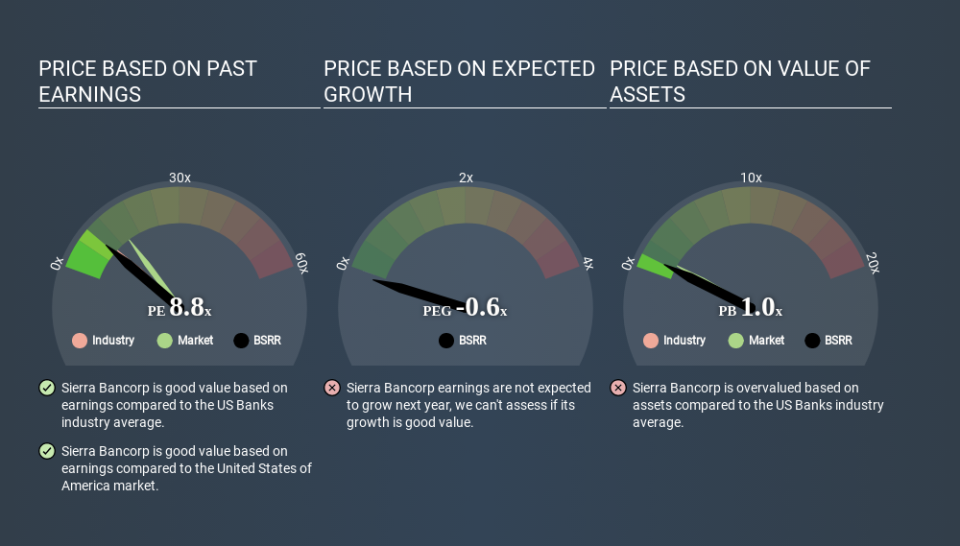What Is Sierra Bancorp's (NASDAQ:BSRR) P/E Ratio After Its Share Price Rocketed?

Sierra Bancorp (NASDAQ:BSRR) shareholders are no doubt pleased to see that the share price has bounced 31% in the last month alone, although it is still down 27% over the last quarter. But shareholders may not all be feeling jubilant, since the share price is still down 27% in the last year.
All else being equal, a sharp share price increase should make a stock less attractive to potential investors. While the market sentiment towards a stock is very changeable, in the long run, the share price will tend to move in the same direction as earnings per share. So some would prefer to hold off buying when there is a lot of optimism towards a stock. One way to gauge market expectations of a stock is to look at its Price to Earnings Ratio (PE Ratio). A high P/E ratio means that investors have a high expectation about future growth, while a low P/E ratio means they have low expectations about future growth.
View our latest analysis for Sierra Bancorp
Does Sierra Bancorp Have A Relatively High Or Low P/E For Its Industry?
We can tell from its P/E ratio of 8.80 that sentiment around Sierra Bancorp isn't particularly high. If you look at the image below, you can see Sierra Bancorp has a lower P/E than the average (9.8) in the banks industry classification.
This suggests that market participants think Sierra Bancorp will underperform other companies in its industry. While current expectations are low, the stock could be undervalued if the situation is better than the market assumes. If you consider the stock interesting, further research is recommended. For example, I often monitor director buying and selling.
How Growth Rates Impact P/E Ratios
P/E ratios primarily reflect market expectations around earnings growth rates. When earnings grow, the 'E' increases, over time. That means unless the share price increases, the P/E will reduce in a few years. Then, a lower P/E should attract more buyers, pushing the share price up.
Sierra Bancorp's earnings per share grew by 9.3% in the last twelve months. And earnings per share have improved by 16% annually, over the last five years.
Remember: P/E Ratios Don't Consider The Balance Sheet
Don't forget that the P/E ratio considers market capitalization. That means it doesn't take debt or cash into account. Theoretically, a business can improve its earnings (and produce a lower P/E in the future) by investing in growth. That means taking on debt (or spending its cash).
Such spending might be good or bad, overall, but the key point here is that you need to look at debt to understand the P/E ratio in context.
How Does Sierra Bancorp's Debt Impact Its P/E Ratio?
Sierra Bancorp's net debt is 7.4% of its market cap. So it doesn't have as many options as it would with net cash, but its debt would not have much of an impact on its P/E ratio.
The Bottom Line On Sierra Bancorp's P/E Ratio
Sierra Bancorp's P/E is 8.8 which is below average (14.4) in the US market. The company hasn't stretched its balance sheet, and earnings are improving. If growth is sustainable over the long term, then the current P/E ratio may be a sign of good value. What we know for sure is that investors are becoming less uncomfortable about Sierra Bancorp's prospects, since they have pushed its P/E ratio from 6.7 to 8.8 over the last month. For those who like to invest in turnarounds, that might mean it's time to put the stock on a watchlist, or research it. But others might consider the opportunity to have passed.
Investors should be looking to buy stocks that the market is wrong about. If the reality for a company is not as bad as the P/E ratio indicates, then the share price should increase as the market realizes this. So this free visual report on analyst forecasts could hold the key to an excellent investment decision.
Of course, you might find a fantastic investment by looking at a few good candidates. So take a peek at this free list of companies with modest (or no) debt, trading on a P/E below 20.
If you spot an error that warrants correction, please contact the editor at editorial-team@simplywallst.com. This article by Simply Wall St is general in nature. It does not constitute a recommendation to buy or sell any stock, and does not take account of your objectives, or your financial situation. Simply Wall St has no position in the stocks mentioned.
We aim to bring you long-term focused research analysis driven by fundamental data. Note that our analysis may not factor in the latest price-sensitive company announcements or qualitative material. Thank you for reading.

 Yahoo Movies
Yahoo Movies 

